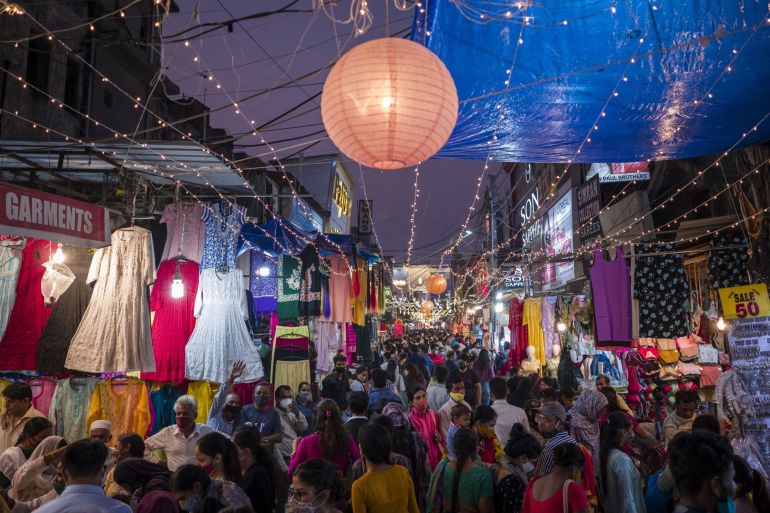India’s economic recovery gathers pace as Omicron looms
India’s GDP is expected to strengthen in the July-September quarter, helped by an uptick in consumer spending.

India is expected to remain on track to post the fastest economic growth among major economies even as the spread of the Omicron coronavirus variant has raised fears for the future.
The country’s economic recovery is expected to strengthen in the July-September quarter, helped by an uptick in consumer spending, data due later Tuesday is expected to show.
Keep reading
list of 4 itemsIndia opens to fully vaccinated foreign tourists
‘Much safer now’: Is India past the worst of COVID pandemic?
India to tighten testing for tourists as new COVID variant found
Asia’s third-largest economy has been seeing a rebound from last year’s deep slump, boosted by rising vaccination rates and increased government spending.
A Reuters survey of 44 economists projected GDP data will show 8.4 percent year-on-year growth in the September quarter, the fastest pace among major economies, vs a 7.5 percent contraction in the same quarter last year.
The projected growth is slower than 20.1 percent growth in the previous quarter – which largely reflected a bounce back from last year’s crash – but marks a fourth straight quarter of expansion.
The recovery is “led by the services sector, with individual mobility back to pre-COVID levels, and ultra-accommodative financial conditions,” as well as higher government expenditures, said Gaura Sen Gupta, an economist with IDFC First Bank in Mumbai.
While she said it was too early to predict the impact of the omicron strain, the cost of lockdowns has been falling as they become more targeted and shorter.

The improvement in workplace mobility became possible due to the government’s extensive vaccination programme, Sunil Sinha, principal economist at India Ratings and Research, said in a statement emailed to Al Jazeera. Cumulative vaccinations in India leapfrogged to 890.21 million at the end of the September quarter, up from 335.72 million at the end of the previous quarter, the ratings agency said.
Sinha, however, warned that growth numbers should be “interpreted with caution” as growth in the first six months of the current financial year was “mainly due to the lower base” of the same period last year.
Fast-moving indicators including exports, electricity generation, rail freight and bank deposits showed improving signs of growth momentum in October while vehicle sales, fuel sales and tax collection showed slower growth.
Testing at airports
Private economists have said the economy is on the cusp of recovery helped by a resilient farm sector growth, but risks included slowing global growth, rising manufacturing prices as well as new variants of COVID-19.
As the market awaited the figures, health authorities warned they were tightening testing at airports in the wake of the spread of the Omicron variant. Prime Minister Narendra Modi on Saturday ordered a review of plans to ease travel curbs.
“COVID risks have resurfaced globally and (these need to be watched) for implications for the timing of monetary policy normalization,” Shubhada Rao, economist at Mumbai-based QuantEco Research, said.
The Reserve Bank of India (RBI), which has cut key interest rates to record lows and infused massive liquidity to shore up the economy, is widely expected to suck out liquidity before normalising rates amid growing inflationary concerns.
RBI has forecast annual growth of 9.5 percent in the current fiscal year.